For the past 5 years, our family has been living without running water. Instead, we live with what I have heard referred to as “walking water.” In our case, the walking part has been quite literal – walking hundreds of gallons of water in buckets from one place to another.
This post may contain affiliate links. Please read my Privacy Policy & Disclosures for more information.
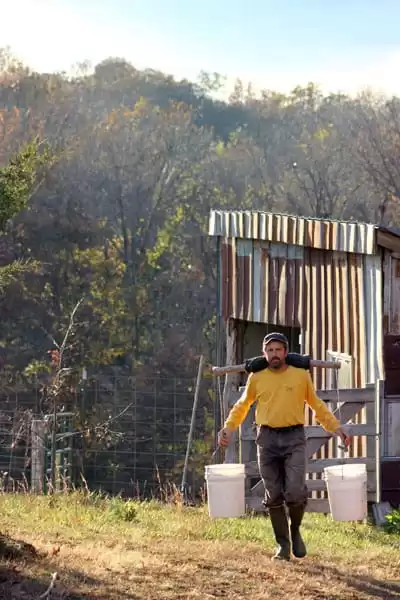
I admit, living without running water has been one of the bigger challenges of developing a homestead from scratch, particularly when our dreams, plans, and actions include planting hundreds of fruit trees and two large gardens, raising chickens, ducks, lambs, bees, dairy cows, and keeping a family of four clean, fed, and hydrated.
Why Live Without Running Water?
Honestly, when we moved to NE Missouri, we didn’t set out to live without running water, but we were very excited to try water catchment.
We had a well at our Oregon homestead, and several of our friends and neighbors here in Missouri have city water. But we chose to build a home at the end of a 1/4 mile gravel dead-end road, atop a hill.
The logistics and expense of piping in water or digging a well were overwhelming to our budget. We decided to start with water catchment and see how it went.
We learned that it is a viable option for us if we continue to add to our water storage capacity, preferably with an underground cistern.
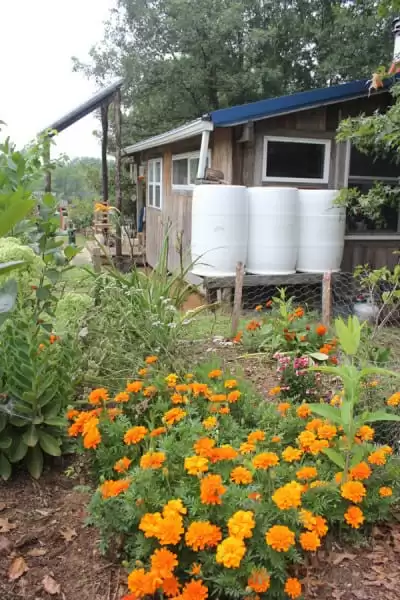
How Do We Collect and Store Rainwater?
In practical terms, what does living without running water look like? First, and most importantly, it involves catching water and storing it.
We collect water from two sources:
- Every metal roof of our homestead
- A homestead pond
We were so fortunate to move onto a piece of property that already had a large, deep pond within close distance to our home site. The pond is ringed by willows and cattails, is remarkably clear and cold, is fed from a watershed completely housed on our land, and is incredibly private. We use pond water for animals, gardens, bathing, and some household use.
We also collect rainwater from the metal roofs of our house, toolshed, cow barn, and chicken coop. Water is collected via gutters into 50-gallon food-grade barrels (which we purchased at our local Pepsi Co. distributor for about $10 per barrel).
We have a total of 550 gallons of water storage, as well as a 50-gallon stock tank. In the winter months, freezing is an issue, so we take our barrels “offline” but do collect snowmelt and rainwater into open buckets and containers that we store indoors or in our homestead root cellar.
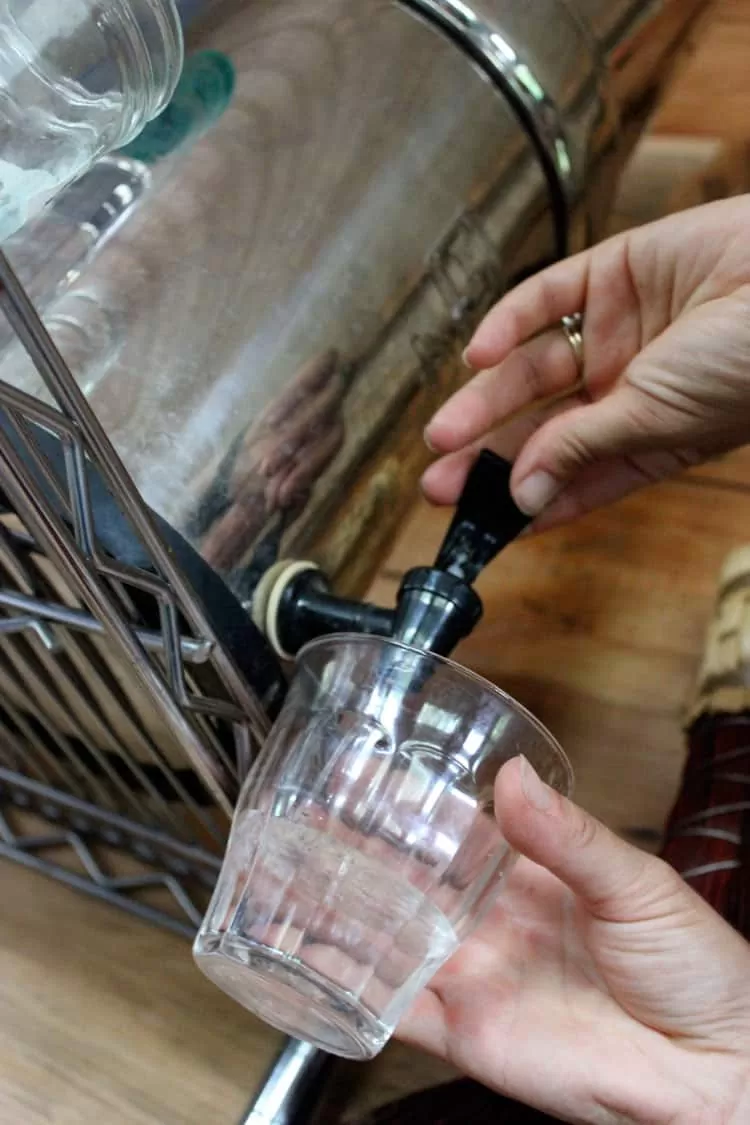
How Do We Collect and Filter Water for Drinking and Cooking?
We have a Berkey Water Filter that we use to render our cooking and drinking water potable. We use rain and snowmelt exclusively in our Berkey, although in an emergency situation, we could filter pond water.
Our Berkey is one of my favorite homestead tools. Not only does it make it possible for us to continue living without running water, but it makes the water taste delicious. I highly recommend it for any homesteader, as you can use it for emergency filtration as well as day to day use.
Water for drinking and cooking represents a mere fraction of our overall water use; I’d estimate we use about 2 gallons per day. We have the Big Berkey model that filters 3.75 gallons of water per hour, and it is more than adequate for our family of four’s needs. If we host guests, we try to get ahead of our water filtration and set some aside to meet the needs of more people.
Collecting Water for Animals, Plants, and Household Use
Because this is the bulk of our water usage, we end up fetching most of the water we need for plants, animals, and house from the pond, carrying five-gallon buckets by hand.
We have thought about purchasing a solar water pump to move water from the pond to our home site, but we’re still debating over the investment. Our neighbors’ topography has enabled them to build a pond at an elevation higher than their garden; with a freeze-proof hydrant, they have a year-round source of water for gardens and animals.
The chicken coop and cow barn both have barrels/stock tanks to meet their water needs, so in the summer months, watering our animals is quite simple. Keeping the animals watered in winter is more difficult, as our winter water protocol at this time is rather rustic.
How to Water the Garden without Running Water
That leaves the following:
- Garden
- Dishes
- Fruit Trees
- Bathing/Showers
- Miscellaneous water use
The fruit trees have been the easiest to keep watered because we use greywater from our dishwashing. We collect our greywater in five-gallon buckets and water our trees in rotation.
We are committed to very clean dishes (no greasy residue), so that means heating water on the woodstove, rocket stove, propane stove, or in the Sun Oven for each and every batch of dishes. We’ve found that washing dishes with cold water just does not cut it. We pour hot water and biodegradable dish soap into a plastic bin for washing and simply pour clean water over dishes to rinse.
The garden’s water needs largely depend on rainfall. I’ve gotten very good at following the forecast, anticipating the rain, and sowing seeds accordingly.
When we are blessed with rain every 1-2 weeks, the garden needs very little irrigation. However, in a drought situation, we have to hand water, and this involves many, many trips to the pond.
This summer’s two-month drought meant that some plants just didn’t make it. I ended up with a much smaller fall/winter garden than I had planned.
Bathing Without Running Water
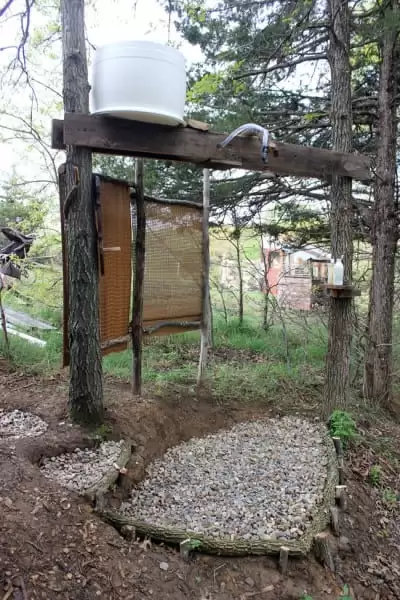
I know you’re all thinking – How do we stay clean living without running water?
In the summer months, we swim daily in our homestead pond. This keeps us all pretty clean, and we also take showers in the super-awesome outdoor shower that my husband built this spring.
In the winter months, we keep things very simple. Every Sunday is “Bath Sunday” and we each have a turn taking a bucket shower in front of the woodstove. It’s so very Little House on the Prairie! We also have a YMCA membership, and workout time leads nicely into hot shower time.
Future Plans for Water Catchment and Water Storage
We seem to be able to tackle one large homestead project every six months. First, our house, then a tool shed. Next, our solar electric system, followed by a cow and cow barn, and finally, a homestead root cellar.
We were able to watch our neighbors construct a concrete water cistern this summer, and learned much from their experience, and also from our experience constructing a root cellar. Next summer, I imagine we’ll install an underground cistern for house water, and perhaps a solar water pump for our gardens.
In some ways, it’s ironic, and perhaps a sign of our times, that we have high-speed Internet, but are living without running water! And some days there is a lot of stress involved with not having a faucet that turns on and off. But most of the time, I feel a huge sense of relief that we are able to provide our family with amazing tasting, clean, and non-treated water.
All in all, having no running water has become part of our lives and we have found ways to bathe, cook, and water the plants that work for us as a family with young children. For tips on how to survive temporarily without running water, check out this post or head over to this article!
Interested in learning more about how we created an off-grid homestead on raw land? Check out my eBook, Creating Your Off-Grid Homestead. This 95-page downloadable eBook is packed with practical advice, encouragement, and information to help you create your own off-grid homestead.
Pin it for Later:
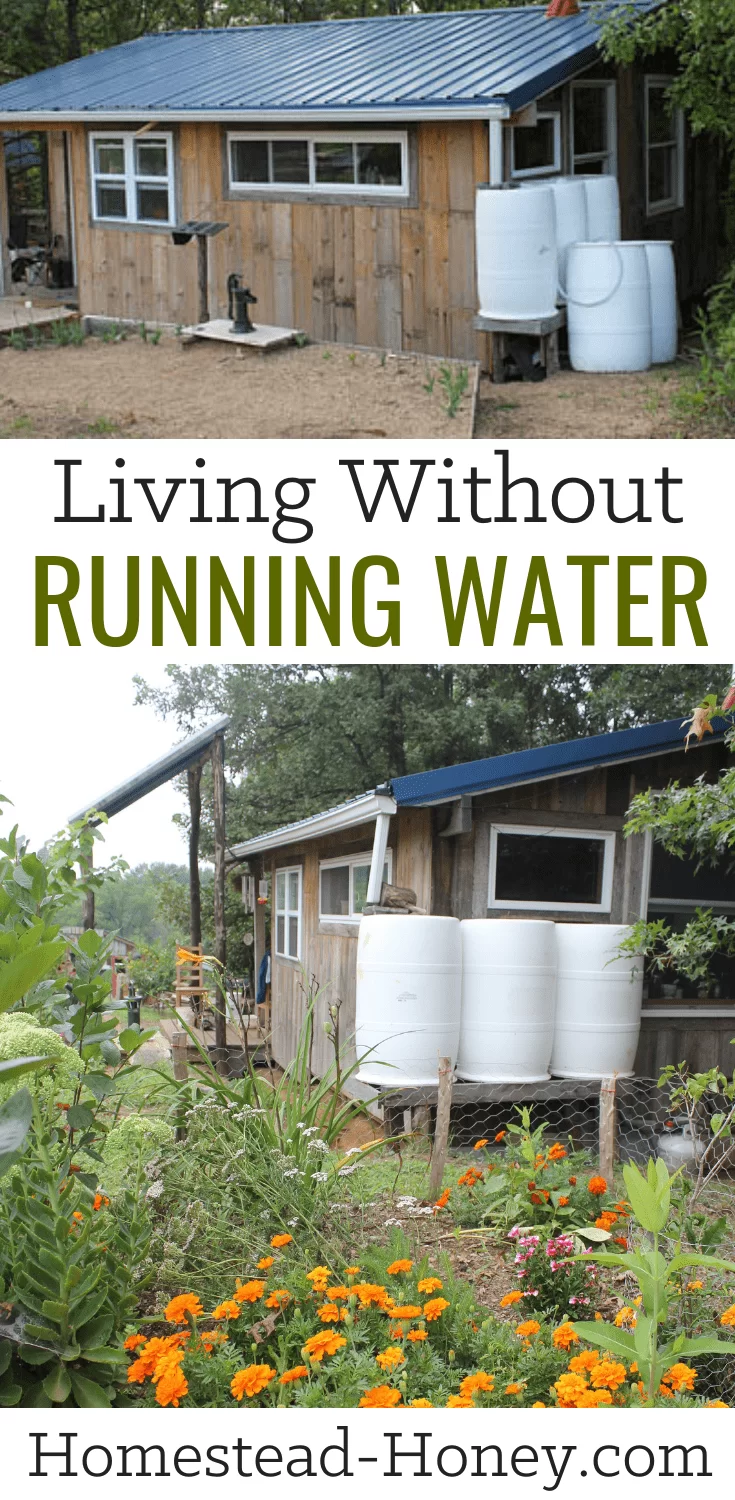
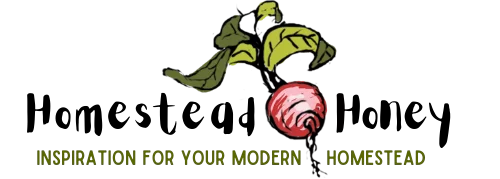
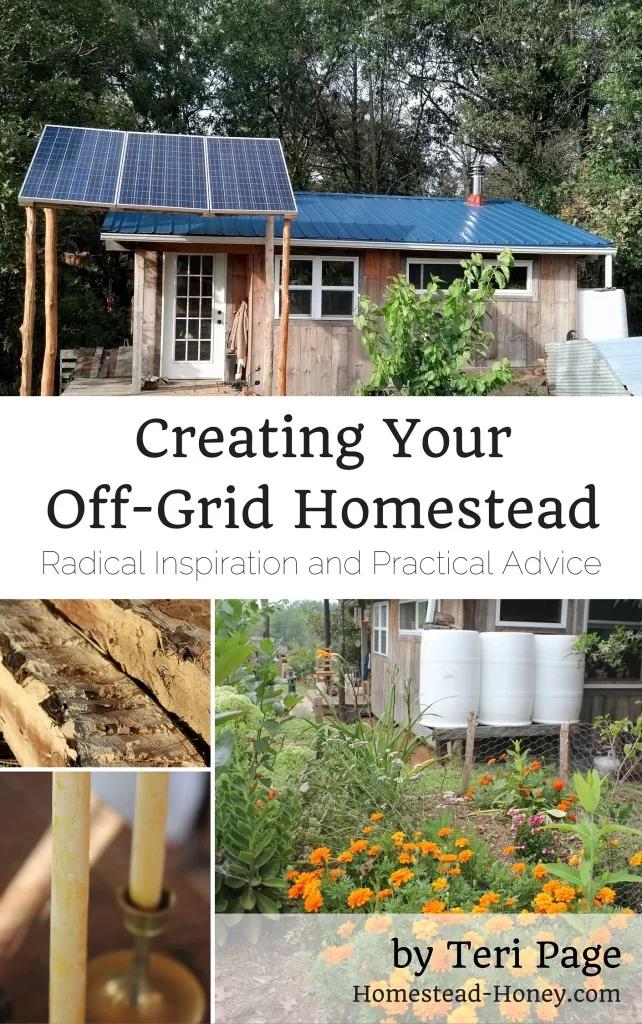
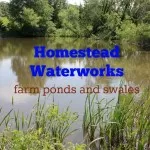
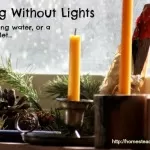
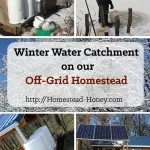
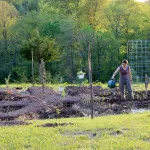

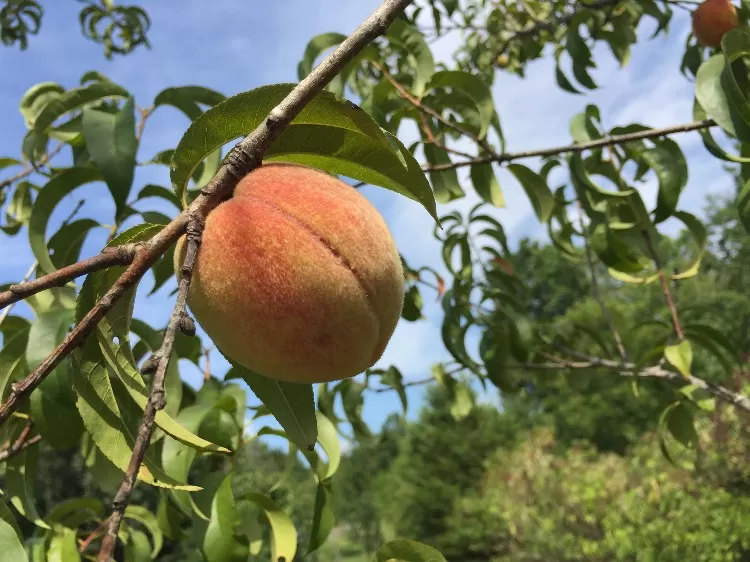


Hi Tery,
I came across this article of yours dealing with water and off-grid living, while I am exploring the idea of buying some land to build a permaculture garden, and eventually off grid cabin. Since we live in the city and won’t to be on the land full time, won’t be able to water the garden during hot spells. I’ve been exploring with the idea of hugelkultur method of gardening. It seems that the large logs and smaller branches act as sponges and can therefore keep roots hydrated longer..if this works it might help to cut back on some of the manual watering during dry spells, ..for us this is an autumn 2016 project so I will only know results after summer 2017 growing season.
By the way, I would be curious to know how your lasagna layered garden compares to the tilled garden, in water needs? A lasagna layered garden is another possibility we are considering and am curious to know if it actually needs less constant watering.
Thanks for sharing your experiences and especially your honesty, it is very inspiring!
Rachel A.
Hi Rachel, Our gardens are all raised beds, and one of the benefits of raised beds is that water drains from the bed more easily, allowing you to plant earlier in the spring, or after a good soaking. However, a disadvantage is that the beds can dry out quickly. I try to keep all of my beds heavily mulched with straw, and that does help during dry spells. But I find that if we go longer than 10 hot days with no rain, my garden looks very, very sad. And this year we had three weeks of drought in June, and my plants were young and unestablished. They really suffered and the occurrence of pests and disease has been very high. However, I have not noticed a huge difference in the water needs between the lasagna garden and the tilled garden. Both seem to dry out at about the same rate. Hope that helps!
Teri
I have a apt garden small Milwaukee Wi malch wood chips,I have to water Hot summer watered once a week,or lose plants Jeff jschwersinske@att.net
*All folks can Conserve A LOT of H20* and help folk’s backs by going …..
* alcohol, coffee,carbonated drinks. hair/clothing/acid drawing dyes ,tanneries FREE
* ALL dyes and organic dyes use A LOT of h20
*bugs and cigs in bin instead or cig free altogether
*indigenous h20 low foliage for geographic area**** BEES!
*chickens, bunnies, goats bugs are economical ( and if already dead fur/ bone for jewelry/decor)
*above ground composite-pyramid w/ rain garden aspects (actually easy )
* haircuts, organic gemstones (avoid drilling), bean beads, hair braiding
* Use bamboo and composite siding for all dwellings and go h20 paint free
* GOING HEAVY METAL FREE, but because of housetop already- use a greenmat and create a bee garden on houstop
Wonderful article – you’re so inspiring. It looks like a lot of effort and very difficult, but that makes it more wonderful. Great to know it can be done, though. Thank you!
Thank you Sarah! It is a lot of work, but I do love our homestead! Thank you for reading! – Teri
Im living in a apt,help rent,old women nasty,talk stuff,Im 60 retired health try to find a place to live can spend 1/2 my check pay for land 5 or 10 acer land shack,north central Wi 10 acer with run down house have to tare down $55.000 got trees a river deer turkeys,there is a house a cross rd have to plant trees info how to move away cheap,just me,want out of Milwaukee Wi Jeff Schwersinske jschwersinske@att.net
If there is anything you want to know about using the wind for power you will find it wiihtn the almost 500 pages of this book. From the history of using wind mills to pump water to the latest giant sized multi megawatt units, it’s here. Want to know about the laws of connecting your wind generating unit to the commercial grid, it’s here. Want to know the wind generation potential in the island nation of Vanuatu in the South Pacific or in your own state, it’s here (along with URL’s to tell you where to get more detailed information. Want a list of magazines, books, manufacturers, or software to help you site the tower, yup, it’s here. Wind power generation has grown significantly since the price of oil has gone up and the extra added costs of polution have become apparent. In the last two decades, wind power system designs have been developed, matured and become a lot more practical than they were only a few years ago. This book is actually the most recent generation of Paul Gipe’s books. It’s the most complete, the most thoroughly developed of anything on the subject.
Thanks for the resource suggestion!
I did,nt get yet,I want a shack in wood,I need your info thanks garden hunt back yard Want,me & my Dakota.Jeff
Hi Jeff,
I think you might want to connect with some folks in your area for assistance. I know your desire to have a garden and homestead is strong, and I hope your neighbors and community can help you make that happen.
Thanks, I have to find where to go,frist have to take care of things,keep email coming like,thanks.Jeff
I shared this post with my friend – she and her husband purchased raw land last year and have been working to clear pasture areas. They currently have a camper there, a shed for their equipment, and they have at least one spring on their land. She is impatient to move to the property, but they are taking it slowly and staying out of debt. This encouraged her to consider ways of getting out of the city and up to her land sooner rather than later. Thanks for the inspiration to us all!
That’s great! Glad to know it was a help!
We are very lucky to live in a float cabin on a fresh water lake. All the water we need is four feet below our floor. We have a hand pump at the kitchen sink. That’s our water source for drinking, cooking, washing dishes, bathing, etc. For drinking and cooking, we boil the water. Most of the year we are the only people living on the lake, so I don’t worry as much about water quality. In summer when the seasonal residents arrive I boil it a bit longer. But we’ve never had a problem in fourteen years. I have a floating garden and use a solar panel, battery and boat bilge pump to draw water for my garden hose. I dip buckets for my garden pots on the deck. Up on the top of our granite cliff I have a small garden patch. Rather than carry water up four flights of stairs I use a tarp to catch rain and store it in two 55-gallon barrels. They are farther up the hill so the hose uses gravity feed. With several rain storms during the summer my water usually lasts until about July. Then my garden (usually potatoes) has to make do with nightly dew or an unexpected rain. The potatoes don’t grow as large up there, but even the small ones are good to eat. I admire you for making do on a large homestead without running water. All I have to deal with is a 675 square foot cabin and a small kitchen garden. – Margy
I mest up on well I get your email ok,got to find my place let,info thanks.Jeff
Hi there,
Thank you so much for sharing your story. I’m enjoying reading all about it. Have you considered a ram pump for moving water between your pond and your vegetables and fruit trees? A ram pump operates without electricity, solar or otherwise, with the use of moving water. I’m not sure what your tributary situation is exactly, but if you think you could spare a few psi at that source, a ram pump might be able to replace your need for manual irrigation. There are a few plans online worth checking out if you wanted to take the time to build one. http://www.motherearthnews.com/diy/hydraulic-ram-pump-zmaz79mjzraw.aspx
I hope this helps. I’m on to your next post!
Chiara
Thank you for the suggestion! Our pond and most of our homestead are at the same elevation, so we don’t have much flow or pressure. However, it might be an option for livestock watering downhill. Thanks for the resource and we’ll look into it!
Could you share with me where you got the harness your husband is wearing carrying the 2 five gallon buckets? My son is farming, and I know he carries lots of those buckets. I would like to get him one of those harnesses to help with the wear and tear of the muscles. Thank you for any information on this. karen
Karen, my husband would love you for asking! He made it himself out of a piece of wood, with a camping ground mat wrapped around the neck/shoulder area, and some rope tied on to help hold the buckets. It is very helpful, and not very difficult to make.
Wow, Teri, I’m impressed! You are one hardcore homesteader! Keep up the good work.
Hi Teri – I’ve been reading everything you’ve ever posted in the last couple of weeks, and I am greatly motivated and inspired by your blog. Shortly, my family might undertake the adventure of downsizing and moving into a small cabin we are just putting the finishing touches to. The cabin is around 700 square feet, and though we have plans to expand it later, as time and budget allow, initially it will have to do for our family of 5. Certainly it’s not as tiny as your home, but we’ll be having our kitchen indoors. Anyway, I will continue checking for updates and enjoying the experience you share here.
Hi Anna,
Thanks for your message! A 700 square foot home sounds just lovely. We’d sure fit in more comfortably if we had a few hundred extra square feet. Although we do have the outdoor kitchen, our house is actually 1/4 kitchen, and 1/8 dining room/pantry. Another 1/8 mudroom and that leaves 1/2 for our bedroom and living room! It’s a tight squeeze! Good luck with your cabin! teri
some states wont let you live like a cowboy,info thanks.Jeff
Back when i was a little boy -just kidding, i’m a girl- Dad got a B52 3000 Gallon Gas Tank and framed it on top of the hill behind our cabin on Garrison Bay, THEN built a 300 Gallon tank (plywood and fiberglass), mounted it on a trailer, and IN SUMMERs used it to load up on water at the Public Utility. He had an electric pump to get the water up into the 3000 Gallon tank and then the whole rest of the water system was simple Gravity Feed through pipes to the house and out buildings. This is back in the 1950-6-‘s. He died, but i lived there with my kids and and had to do the Jugs Of Water Deal for months until getting the electricity on the the well pump fixed ( by the 1980’s there was a well but we had to drain the system in freezes) .. . Dad’s family of Mom and 6 daughters and my family of me and 3 little kids never suffered from this, although all but me never get into a future spot where the water doesn’t run HOT AND COLD out of a faucet!
Sounds like quite the adventure!!!
Hello
new to your blog an email updates really enjoy them in southwest Mo here not homesteading but enjoy the ideas you have an come up with have helped build a couple homestead cabins for friends and a few gravity feed water systems i build out of salvage lumber so always want to know what others are doing I grew up on hauled water as a kid and a few times as an adult from as close as a well outside the door to 20 miles in Taos NM one thing you might try for moving water around is find an RV salvage or someone who has a old junk RV an get the 12volt water pump out of it to help move water around on the cheap have one in my garage for just that if i need it dont buy a new one there expensive but see what you can trade for
Great! Thanks for the tip! Seems like there are dozens of old RVs sitting around here!
Hi Teri,
Thanks for sharing your homesteading adventures with us. My hubby and I aren’t technically homesteaders, but we did build a traditiinal hand-hewn log cabin in a rural Ohio woodland eighteen years ago, complete with plumbing, electricity, vegetable garden and a nature pond. We had hoped to simplify our lives, and in some ways we succeeded, although sometimes it can be tricky co-existing with nature as it tries to regain lost ground! lol My question is, how do you effectively wash clothing? You may have blogged about this and I’ve forgotten.
Hi Deni,
Yes, I did blog about this! I wish it was more glamorous, but right now, we’re using the laundromat and line drying. But you can read the whole post on the blog – just do a search for laundry!
Great article, Teri! I love the ingenuity that you and your family show. Please reach out to me regarding the solar water pump. I am happy to help you. We have been doing a number of renewable projects, and there may be some VERY cost effective options for you. Keep doing well, cousin! Love to the family.
Hey Cousin! That’s great to know! I told Brian to get in touch with you when he’s ready to talk pump. After this root cellar project, I think he’s ready for a few months of rest!! Love to you all!
Hi Teri, I love reading your blog, it’s very inspiring! I was wondering, is your family vegetarian? I read somewhere that you can’t use grey water for watering plants, even after filtering, when you have animal grease in the water. Do you know anything about that? Thanks! Kind regards, Marjolein (The Netherlands)
Hi Marjolein,
We are not vegetarians, and so our dishwater likely has residual animal grease. We do not use this water in the garden,but only on fruit trees. I haven’t observed any troubles as a result of using this greywater. But it’s good to know so I can look into it more!
Teri
awesome post. You guys are really doing it right. We have a pond on our property too that it totally secluded and will make an excellent water source. 🙂
I can’t wait to hear/read about your root cellar. I have been seeing snippets and am very jealous, lol. (Florida here)
Oh, the poor Floridians – I have heard from SO many people who want to build a root cellar in Florida!! I have heard that it is possible in some areas (apparently there is an old homestead in Gainesville that has a root cellar), but I bet it’s very difficult! That’s great that you have a pond!
Wow! You guys are hard core! I really enjoyed reading this. I know how hard homesteading is for us and I cant imagine doing it without running water! There’s so much diversity with homesteaders. Everyone does it their own way and we can all learn from each other. Thanks for sharing your journey with us.
Yes, that is so true – we all learn from each other! It’s one of the reasons I most love having a homesteading blog – I’ve gotten connected with so many other homesteaders, and learn from all of them!
Wow, that is quite challenging! We spent a summer with no running water so I sympathize!
We have many springs on our property so we have lots of water but our pump is too big for our solar system so we have to use the generator to fill our tank which is up on a 20′ tower we built. We are looking at a dankoff slow pump so we can run it off the solar. It uses much less power
Oh, if we had springs, I would be so happy! I have dreams of building a spring house for our dairying. It’s good to hear about your water system. I will look into the pump you mention! Thank you!
Another great article, Teri. Thank you, Ardith P.S. Your Instagram photos are amazing!
Thank you so much!
I want a shack in the country,did,nt do yet find place? live out running water? buckets or a sand point well hand pump? think and Do.Jeff
We have a very small hand pump that extends down into some buried water barrels, and would love to get a larger hand pump system some day!